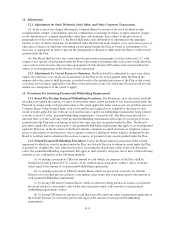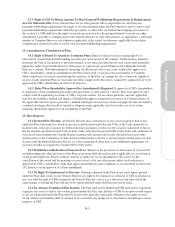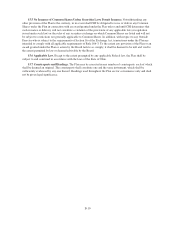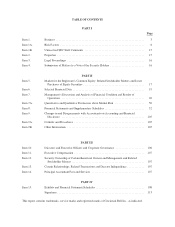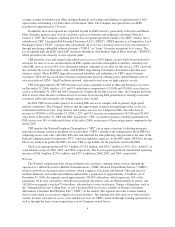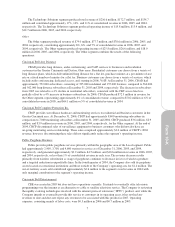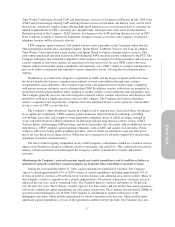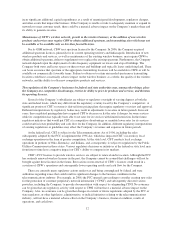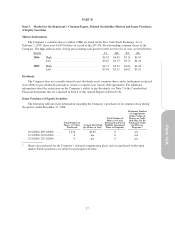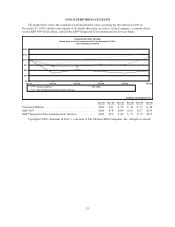Cincinnati Bell 2006 Annual Report Download - page 118
Download and view the complete annual report
Please find page 118 of the 2006 Cincinnati Bell annual report below. You can navigate through the pages in the report by either clicking on the pages listed below, or by using the keyword search tool below to find specific information within the annual report.Broadband
The Company sold substantially all its broadband assets in 2003, which were reported in the Broadband
segment. The Broadband segment no longer has any substantive, on-going operations. The Broadband segment
previously provided data and voice communications services nationwide over 18,700 route miles of fiber-optic
transmission facilities. Operating income in 2006 of $10.4 million consisted of a $4.7 million gain on sale of
broadband fiber assets, $3.6 million of income from the sale of a bankruptcy claim receivable, and $2.9 million
of income due to the expiration of certain warranties and indemnities established at the time the broadband assets
were sold, partially offset by restructuring and legal expenses. Operating income of $12.3 million and $10.7
million in 2005 and 2004 was primarily due to the adjustment of liabilities not assumed by the buyer and, in
2004, also results from the expiration of certain indemnities to the buyer.
Employees
At February 16, 2007, the Company had approximately 2,950 employees. CBT had approximately 1,350
employees covered under a collective bargaining agreement with the Communications Workers of America,
which is affiliated with the AFL-CIO. This collective bargaining agreement expires in May 2008.
Business Segment Information
The amount of revenue, intersegment revenue, operating income (loss), expenditures for long-lived assets,
and depreciation and amortization attributable to each of the Company’s business segments for 2006, 2005, and
2004, and assets as of December 31, 2006 and 2005, is set forth in Note 15 to the Consolidated Financial
Statements.
Item 1A. Risk Factors
The Company’s substantial debt could limit its ability to fund operations, expose it to interest rate volatility,
limit its ability to raise additional capital and have a material adverse effect on its ability to fulfill its
obligations and on its business and prospects generally.
The Company has a substantial amount of debt and has significant debt service obligations. As of
December 31, 2006, the Company and its subsidiaries had outstanding indebtedness of $2.1 billion, on which it
incurred $162.1 million of interest expense in 2006, and had total shareowners’ deficit of $791.6 million. In
addition, the Company had the ability to borrow additional amounts under its revolving credit facility totaling
approximately $245.2 million, subject to compliance with certain conditions. The Company may incur additional
debt from time to time, subject to the restrictions contained in its credit facilities and other debt instruments.
The Company’s substantial debt could have important consequences, including the following:
•the Company will be required to use a substantial portion of its cash flow from operations to pay principal
and interest on its debt, thereby reducing the availability of cash flow to fund working capital, capital
expenditures, strategic acquisitions, investments and alliances, and other general corporate requirements;
•the Company’s interest expense could increase if interest rates, in general, increase because approximately
40% of the Company’s indebtedness is based on variable interest rates;
•the Company’s substantial debt will increase its vulnerability to general economic downturns and adverse
competitive and industry conditions and could place the Company at a competitive disadvantage
compared to those of its competitors that are less leveraged;
•the Company’s debt service obligations could limit its flexibility to plan for, or react to, changes in its
business and the industry in which it operates;
•the Company’s level of debt and shareowners’ deficit may restrict it from raising additional financing on
satisfactory terms to fund working capital, capital expenditures, strategic acquisitions, investments and
joint ventures and other general corporate requirements; and
•a potential failure to comply with the financial and other restrictive covenants in the Company’s debt
instruments, which, among other things, require it to maintain specified financial ratios could, if not cured
or waived, have a material adverse effect on the Company’s ability to fulfill its obligations and on its
business and prospects generally.
8


